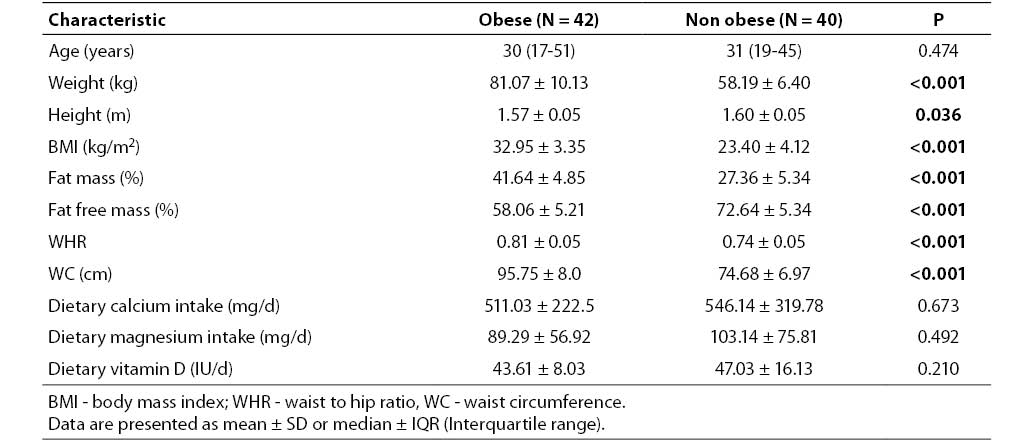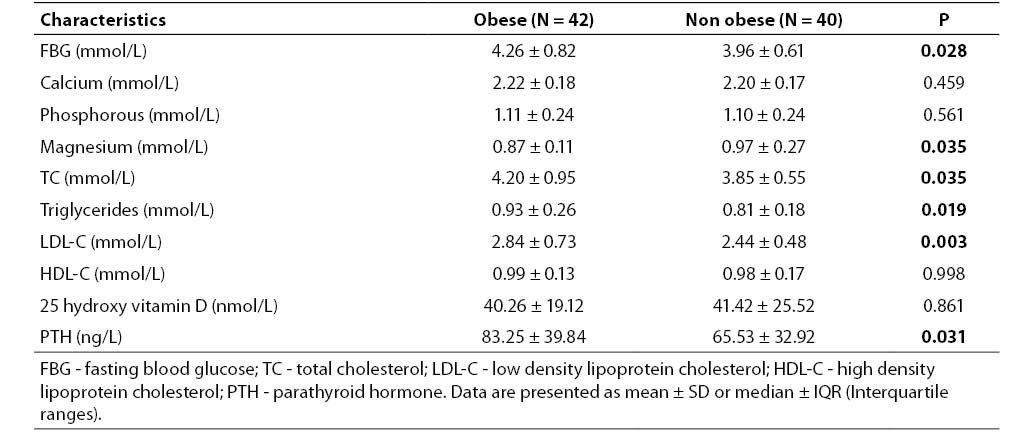References
1. Lind L, Jakobsson S, Lithell H, Wengle B, Ljunghall S. Relation of serum calcium concentration to metabolic risk factors for cardiovascular disease. BMJ 1988;297:960-63.
2. Kennedy A, Vasdev S, Randell E, Xie Y, Green K, Zhang H, et al. Abnormality of serum lipids are independently associated with increased serum calcium level in the adult newfoundland population. Clin Med 2009;2:15-23.
3. Berridge MJ, Lipp P, Bootman MD. The versatility and universality of calcium signalling. Nat Rev Mol Cell Biol 2000;1:11–21.
4. Hagstrom E, Hellman P, Lundgren E, Lind L, Arnlov J. Serum calcium is independently associated with insulin sensitivity measured with euglycaemic-hyperinsulinaemic clamp in a community-based cohort. Diabetologia 2007;50:317–24.
5. Huerta MG, Roemmich JN, Kington ML, Bovbjerg VE, Weltman AL, Holmes VF, et al. Magnesium deficiency is associated with insulin resistance in obese children. Diabetes Care 2005;28:1175-81.
6. Slinin Y, Foley RN, Collins AJ. Calcium, phosphorus, parathyroid hormone, and cardiovascular disease in hemodialysis patients: the USRDS waves 1, 3, and 4 study. J Am Soc Nephrol 2005;16:1788-93.
7. Lind L, Skarfors E, Berglund L, Lithell H, Ljunghall S. Serum calcium: a new, independent, prospective risk factor for myocardial infarction in middle-aged men followed for 18 years. J Clin Epidemiol 1997;50:967-73.
8. Guerrero-Romero F, Rodriguez-Moran M. Low serum magnesium levels and metabolic syndrome. Acta Diabetol 2002;39:209-13.
9. Speich M, Gelot S, Arnaud P, Van GOC. Multiple and simple correlations between magnesium, calcium, zinc, potassium, total-and HDL-cholesterol in 111 reference subjects. Magnes Bull 1984;6:137-41.
10. Nadler JL, Buchanan T, Natarajan R, Antonipillai I, Bergman R, Rude R. Magnesium deficiency produces insulin resistance and increased thromboxane synthesis. Hypertension 1993;21:1024-29.
11. Resnick LM. Hypertension and abnormal glucose homeostasis: possible role of divalent ion metabolism. Am J Med 1989;87:17–22.
12. Mazzone T, Meyer PM, Kondos GT, Davidson MH, Feinstein SB, D’Agostino RB, et al. Relationship of traditional and nontraditional cardiovascular risk factors to coronary artery calcium in type 2 diabetes. Diabetes 2007;56:849-55.
13. Al-Hakeim HK. Serum levels of lipids, calcium and magnesium in women with hypothyroidism and cardiovascular diseases. J Lab Physicians 2009;1:49-52.
14. Skugor M, Gupta M, Navaneethan S. Evolution and current state of assays for measuring parathyroid hormone. Biochem Med 2010;20:221-8.
15. Friedewald WT, Levy RI, Fredrickson DS. Estimation of the concentration of low-density lipoprotein cholesterol in plasma, without use of the preparative ultracentrifuge. Clin Chem 1972;18:499-502.
16. Nagila A, Bhatt M, Poude B. Thyroid Stimulating Hormone and its Correlation with Lipid Profile in the Obese Nepalese Population. J Clin Diag Res 2008;2:932-37.
17. Willett WC, Howe GR, Kushi LH. Adjustment for total energy intake in epidemiologic studies. Am J Clin Nutr 1997;65:1220-28.
18. Marusteri M, Bacarea V. Comparing groups for statistical differences: how to choose the right statistical test? Biochem Med 2010;20:15-32.
19. Jensen J, Nilas L, Christiansen C. Influence of menopause on serum lipids and lipoproteins. Maturitas 1990; 12:321-31.
20. Gallagher JC, Goldgar D, Moy A. Total bone calcium in normal women: effect of age and menopause status. J Bone Miner Res 1987;2:491-96.
21. De Bacquer D, De Henauw S, De Backer G, Kornitzer M. Epidemiological evidence for an association between serumcalcium and serum lipids. Atherosclerosis 1994;108:193-200.
22. Sugimoto T, Tanigawa T, Onishi K, Fujimoto N, Matsuda A, Nakamori S, et al. Serum intact parathyroid hormone levels predict hospitalisation for heart failure. Heart 2009;95:395 -98.
23. Gadallah MF, El-Shahawy M, Andrews G, Ibrahim M, Ramdeen G, Hanna D, et al. Factors modulating cytosolic calcium. Role in lipid metabolism and cardiovascular morbidity and mortality in peritoneal dialysis patients. Adv Perit Dial 2001;17:29-36.
24. Querfeld U, Hoffmann MM, Klaus G, Eifinger F, Ackerschott M, Michalk D, et al. Antagonistic effects of vitamin D and parathyroid hormone on lipoprotein lipase in cultured adipocytes. J Am Soc Nephrol 1999;10:2158-64.
25. Avram MM, Goldwasser P, Burrell DE, Antignani A, Fein PA, Mittman N. The uremic dyslipidemia: A cross-sectional and longitudinal study. Am J Kidney Dis 1992;20:324-35.
26. Akmal M, Kasim SE, Soliman AR, Massry SG. Excess parathyroid hormone adversely affects lipid metabolism in chronic renal failure. Kidney Int 1990;37:854-58.
27. Deighan CJ, Caslake MJ, McConnell M, Boulton-Jones JM, Packard CJ. Atherogenic lipoprotein phenotype in end-stage renal failure: origin and extent of small dense low-density lipoprotein formation. Am J Kidney Dis 2000;35:852-62.
28. Kronenberg F, Kuen E, Ritz E, Junker R, Konig P, Kraatz G, et al. Lipoprotein (a) serum concentrations and apolipoprotein (a) phenotypes in mild and moderate renal failure. Am J Kidney Dis 2000;11:105-15.
29. Sun G, Vasdev S, Martin GR, Gadag V, Zhang H. Altered calcium homeostasis is correlated with abnormalities of fasting serum glucose, insulin resistance, and β-cell function in the Newfoundland population. Diabetes 2005;54:3336-39.
30. Dhingra R, Sullivan L, Fox W, Gaziano MRV. Relations of Serum Phosphorus and Calcium Levels to the Incidence of Cardiovascular Disease in the Community. Arch Intern Med 2007;167:879-85.
31. Park W, Kim BS, Lee JE, Huh JK, Kim BJ, Sung KC, et al. Serum phosphate levels and the risk of cardiovascular disease and metabolic syndrome: a double-edged sword. Diabetes Res Clin Pract 2009;83:119-25.
32. Rodriguez-Moran M, Guerrero-Romero F. Elevated concentrations of TNF-alpha are related to low serum magnesium levels in obese subjects. Magnes Res 2004;17:189-96.
33. Hauner H, Bender M, Haastert B, Hube F. Plasma concentrations of soluble TNF-alpha receptors in obese subjects. Int J obes 1998;22:1239-43.
34. Guerrero-Romero F, Rodriguez-Moran M. Relationship between serum magnesium levels and C-reactive protein concentration, in non-diabetic, non-hypertensive obese subjects. Int J obes 2002;26:469-74.
35. Laimer M, Ebenbichler CF, Kaser S, Sandhofer A, Weiss H, Nehoda H, et al. Markers of chronic inflammation and obesity: a prospective study on the reversibility of this association in middle-aged women undergoing weight loss by surgical intervention. Int J Obes2002;26:659-62.
36. Hotamisligil GS, Arner P, Caro JF, Atkinson RL, Spiegelman BM. Increased adipose tissue expression of tumor necrosis factor-alpha in human obesity and insulin resistance. J Clin Invest 1995;95:2409-15.
37. Purohit A, Ghilchik MW, Duncan L, Wang DY, Singh A, Walker MM, et al. Aromatase activity and interleukin-6 production by normal and malignant breast tissues. J Clin Endocrinol Metab 1995;80:3052-58.
38. Overbergh L, Decallonne B, Valckx D, Verstuyf A, Depovere J, Laureys J, et al. Identification and immune regulation of 25 hydroxyvitamin D 1 hydroxylase in murine macrophages. Clin Exp Immunol 2000;120:139-46.
39. Alcock N, MacIntyre I. Inter-relation of calcium and magnesium absorption. Clin Sci 1962;22:185-93.
40. Draznin B, Sussman KE, Eckel RH, Kao M, Yost T, Sherman NA. Possible role of cytosolic free calcium concentrations in mediating insulin resistance of obesity and hyperinsulinemia. J Clin Invest 1988;82:1848-52.
41. Shi H, Dirienzo D, Zemel MB. Effects of dietary calcium on adipocyte lipid metabolism and body weight regulation in energy-restricted a P2-agouti transgenic mice. FASEB J 2001;15:291-93.
42. McCarty MF, Thomas CA. PTH excess may promote weight gain by impeding catecholamine-induced lipolysis-implications for the impact of calcium, vitamin D, and alcohol on body weight. Med Hypotheses 2003;61:535-42.
43. Parikh SJ, Edelman M, Uwaifo GI, Freedman RJ, Semega-Janneh M, Reynolds J, et al. The relationship between obesity and serum 1, 25-dihydroxy vitamin D concentrations in healthy adults. J Clin Endocrinol Metab 2004;89:1196-99.
44. Kamycheva E, Sundsfjord J, Jorde R. Serum parathyroid hormone level is associated with body mass index. The 5th Tromso study. Eur J Endocrinol 2004;151:167-72.
45. Andersen T, McNair P, Fogh-Andersen N, Nielsen TT. Increased parathyroid hormone as a consequence of changed complex binding of plasma calcium in morbid obesity. Metabolism 1986;35:147-51.












